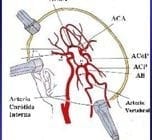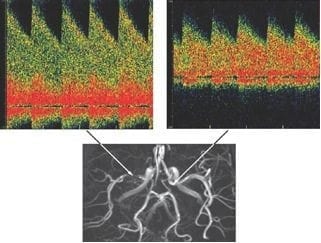Transcranial Doppler (TCD) Ultrasound
OVERVIEW
TCD is a non-invasive technique for monitoring blood flow velocity (FV) in the basal cerebral arteries using Doppler ultrasound
USES
- assessment of blood flow velocity through cerebral arteries is useful for:
- emboli
- stenosis
- vasospasm post SAH
- assessment of cerebral blood flow
DESCRIPTION
- pulsed Doppler probe -> graphs velocity over time


METHOD OF USE
Technique
- uses a 2 MHz probe (low frequency)
- probe on temporal bone -> measure flow in MCA
- phase shift is proportional to the speed of blood
- during vasospasm there is an increase in flow velocity through the narrowed segment that is proportional to the reduction in vessel diameter.
Flow in MCA
- normal flow: mean = 55cm/sec
- mild: > 120cm/sec
- moderate: > 160cm/sec
- severe: > 200cm/sec
Lindegaard Ratio = mean velocity in the MCA / mean velocity in ipsilateral extracranial internal carotid artery
- high velocities in the MCA (>120cm/s) may be due to hyperaemia or vasospasm.
- the Lindegaard Ratio helps distinguish these conditions.
- <3 = hyperaemia
- >3 = vasospasm
-> 3-6 mild
-> >6 severe
OTHER INFORMATION
Interpreting flow
- increases in flow velocity may be vasospasm or hyperaemia (to differentiate compare flow through MCA with flow through ICA)
- reverberant flow (flow forward during systole and backward during diastole) = no sustainable cerebral perfusion pressure
Advantages
- non-invasive
- quick and easily repeatable
- performed at the bedside
- can be used to monitor spasm post-treatment
Disadvantages
- sensitivity 80% compared to angiography
- operator dependent
- poor for distal vessels (i.e. other than MCA and ICA)
- potential confounders include hypo/hypercapnia, haematocrit, BP
- edema and vasospasm may be difficult to distinguish post-op
- difficult views in some patients (e.g. thick skulls!)
References and Links
CCC Neurocritical Care Series
Emergencies: Brain Herniation, Eclampsia, Elevated ICP, Status Epilepticus, Status Epilepticus in Paeds
DDx: Acute Non-Traumatic Weakness, Bulbar Dysfunction, Coma, Coma-like Syndromes, Delayed Awakening, Hearing Loss in ICU, ICU acquired Weakness, Post-Op Confusion, Pseudocoma, Pupillary Abnormalities
Neurology: Anti-NMDA Encephalitis, Basilar Artery Occlusion, Central Diabetes Insipidus, Cerebral Oedema, Cerebral Venous Sinus Thrombosis, Cervical (Carotid / Vertebral) Artery Dissections, Delirium, GBS vs CIP, GBS vs MG vs MND, Guillain-Barre Syndrome, Horner’s Syndrome, Hypoxic Brain Injury, Intracerebral Haemorrhage (ICH), Myasthenia Gravis, Non-convulsive Status Epilepticus, Post-Hypoxic Myoclonus, PRES, Stroke Thrombolysis, Transverse Myelitis, Watershed Infarcts, Wernicke’s Encephalopathy
Neurosurgery: Cerebral Salt Wasting, Decompressive Craniectomy, Decompressive Craniectomy for Malignant MCA Syndrome, Intracerebral Haemorrhage (ICH)
— SCI: Anatomy and Syndromes, Acute Traumatic Spinal Cord Injury, C-Spine Assessment, C-Spine Fractures, Spinal Cord Infarction, Syndomes,
— SAH: Acute management, Coiling vs Clipping, Complications, Grading Systems, Literature Summaries, ICU Management, Monitoring, Overview, Prognostication, Vasospasm
— TBI: Assessment, Base of skull fracture, Brain Impact Apnoea, Cerebral Perfusion Pressure (CPP), DI in TBI, Elevated ICP, Limitations of CT, Lund Concept, Management, Moderate Head Injury, Monitoring, Overview, Paediatric TBI, Polyuria incl. CSW, Prognosis, Seizures, Temperature
ID in NeuroCrit. Care: Aseptic Meningitis, Bacterial Meningitis, Botulism, Cryptococcosis, Encephalitis, HSV Encephalitis, Meningococcaemia, Spinal Epidural Abscess
Equipment/Investigations: BIS Monitoring, Codman ICP Monitor, Continuous EEG, CSF Analysis, CT Head, CT Head Interpretation, EEG, Extradural ICP Monitors, External Ventricular Drain (EVD), Evoked Potentials, Jugular Bulb Oxygen Saturation, MRI Head, MRI and the Critically Ill, Train of Four (TOF), Transcranial Doppler
Pharmacology: Desmopressin, Hypertonic Saline, Levetiracetam (Keppra), Mannitol, Midazolam, Sedation in ICU, Thiopentone
MISC: Brainstem Rules of 4, Cognitive Impairment in Critically Ill, Eye Movements in Coma, Examination of the Unconscious Patient, Glasgow Coma Scale (GCS), Hiccoughs, Myopathy vs Neuropathy, Neurology Literature Summaries, NSx Literature Summaries, Occulocephalic and occulovestibular reflexes, Prognosis after Cardiac Arrest, SIADH vs Cerebral Salt Wasting, Sleep in ICU
- Bathala L, Mehndiratta MM, Sharma VK. Transcranial doppler: Technique and common findings (Part 1). Ann Indian Acad Neurol [serial online] 2013 [cited 2013 May 27];16:174-9. Available from: http://www.annalsofian.org/text.asp?2013/16/2/174/112460
- Moppett IK, Mahajan RP. Transcranial Doppler ultrasonography in anaesthesia and intensive care. Br J Anaesth. 2004 Nov;93(5):710-24. PMID: 15220174.
- White H, Venkatesh B. Applications of transcranial Doppler in the ICU: a review. Intensive Care Med. 2006 Jul;32(7):981-94. PMID: 16791661.
Critical Care
Compendium
Chris is an Intensivist and ECMO specialist at The Alfred ICU, where he is Deputy Director (Education). He is a Clinical Adjunct Associate Professor at Monash University, the Lead for the Clinician Educator Incubator programme, and a CICM First Part Examiner.
He is an internationally recognised Clinician Educator with a passion for helping clinicians learn and for improving the clinical performance of individuals and collectives. He was one of the founders of the FOAM movement (Free Open-Access Medical education) has been recognised for his contributions to education with awards from ANZICS, ANZAHPE, and ACEM.
His one great achievement is being the father of three amazing children.
On Bluesky, he is @precordialthump.bsky.social and on the site that Elon has screwed up, he is @precordialthump.
| INTENSIVE | RAGE | Resuscitology | SMACC
